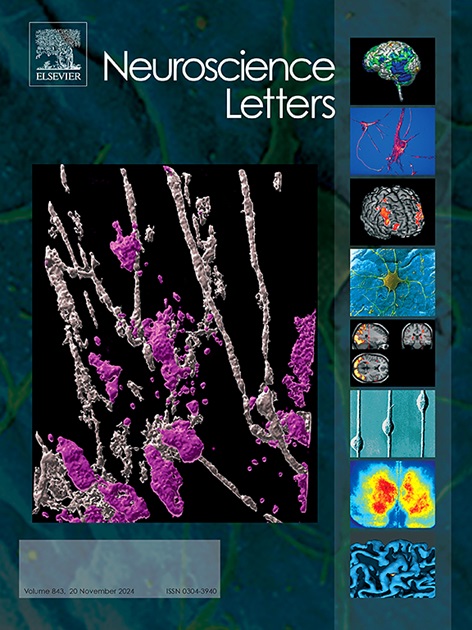在雄性大鼠中,年龄依赖性的凋亡增加与miR-92a/Akt/mTOR和NF-κB信号通路的失调有关。
IF 2
4区 医学
Q3 NEUROSCIENCES
引用次数: 0
摘要
脑老化是大多数神经退行性疾病的主要危险因素,并与神经元的高损失率有关。因此,确定神经元丢失和药理调节的分子机制对于减缓或预防与年龄相关的疾病可能非常重要。在此,我们研究了miR-92a、Akt、mTOR和NF-κB在雄性大鼠海马(参与脑衰老的关键结构)中与年龄相关的凋亡中的作用。24只雄性Wistar大鼠分为幼龄对照组(3月龄)、老年组(18月龄)和老年 + 哌唑嗪组(各 = 8只)。 哌唑嗪(1毫克/公斤;给老龄大鼠ig (i.p.) 4 周。TUNEL染色检测细胞凋亡。对Akt、mTOR、NF-κB进行Western blot检测。RT-PCR检测miR-92a基因表达。结果表明,衰老海马细胞凋亡明显增强。我们还检测到衰老海马中NF-κB的显著上调以及磷酸化akt和mTOR的显著下调。此外,miR-92a基因在衰老海马中的表达明显降低。prazosin显著抑制衰老海马细胞凋亡,逆转miR-92a基因表达以及Akt、mTOR、NF-κB蛋白表达。考虑到NF-κB对mirna的调控作用,我们的研究结果表明NF-κB可能是miR-92a的负转录调控因子,进而调控Akt/mTOR信号通路。因此,NF-κB上调可能介导miR-92a/Akt/mTOR轴下调,从而参与年龄相关性神经退行性变。这可能为延缓或预防与年龄有关的问题提供新的治疗靶点。本文章由计算机程序翻译,如有差异,请以英文原文为准。

Age-dependent increase in apoptosis is associated with dysregulation of miR-92a/Akt/mTOR and NF-κB signaling pathways in male rats
Brain aging is the leading risk factor for most neurodegenerative diseases and has been linked with high rates of neuron loss. Thus, identifying molecular mechanisms underlying neuron loss and pharmacological modulation may be of great importance for slowing or preventing age-related diseases. Herein, we investigated the roles of miR-92a, Akt, mTOR, and NF-κB in age-associated apoptosis in the hippocampus (a critical structure involved in brain aging) of male rats alone and in combination with prazosin. Twenty-four male Wistar rats were grouped into young control (3-month-old), aged (18-month-old), and aged + prazosin groups (n = 8 for each). Prazosin (1 mg/kg; i.p.) was administered for 4 weeks to aged rats. Apoptosis was detected by TUNEL staining. Western blot for Akt, mTOR, and NF-κB was conducted. miR-92a gene expression was performed by using RT-PCR. The results indicated a marked enhancement of apoptosis in the aging hippocampus. We also detected substantial up-regulation of NF-κB as well as substantial down-regulation of phosphorylated-Akt and mTOR in the aging hippocampus. Moreover, miR-92a gene expression was markedly reduced in the aging hippocampus. Treatment with prazosin significantly suppressed apoptosis and reversed miR-92a gene expression, as well as Akt, mTOR, and NF-κB protein expressions in the aging hippocampus. Considering the NF-κB regulatory role on miRNAs, our results suggest that NF-κB may be a negative transcriptional regulator of miR-92a, which in turn could regulate the Akt/mTOR signaling. In this regard, NF-κB upregulation may mediate the downregulation of miR-92a/Akt/mTOR axis, and thereby contribute to age-related neurodegeneration. This may provide a novel treatment target for delaying or preventing age-related problems.
求助全文
通过发布文献求助,成功后即可免费获取论文全文。
去求助
来源期刊

Neuroscience Letters
医学-神经科学
CiteScore
5.20
自引率
0.00%
发文量
408
审稿时长
50 days
期刊介绍:
Neuroscience Letters is devoted to the rapid publication of short, high-quality papers of interest to the broad community of neuroscientists. Only papers which will make a significant addition to the literature in the field will be published. Papers in all areas of neuroscience - molecular, cellular, developmental, systems, behavioral and cognitive, as well as computational - will be considered for publication. Submission of laboratory investigations that shed light on disease mechanisms is encouraged. Special Issues, edited by Guest Editors to cover new and rapidly-moving areas, will include invited mini-reviews. Occasional mini-reviews in especially timely areas will be considered for publication, without invitation, outside of Special Issues; these un-solicited mini-reviews can be submitted without invitation but must be of very high quality. Clinical studies will also be published if they provide new information about organization or actions of the nervous system, or provide new insights into the neurobiology of disease. NSL does not publish case reports.
 求助内容:
求助内容: 应助结果提醒方式:
应助结果提醒方式:


